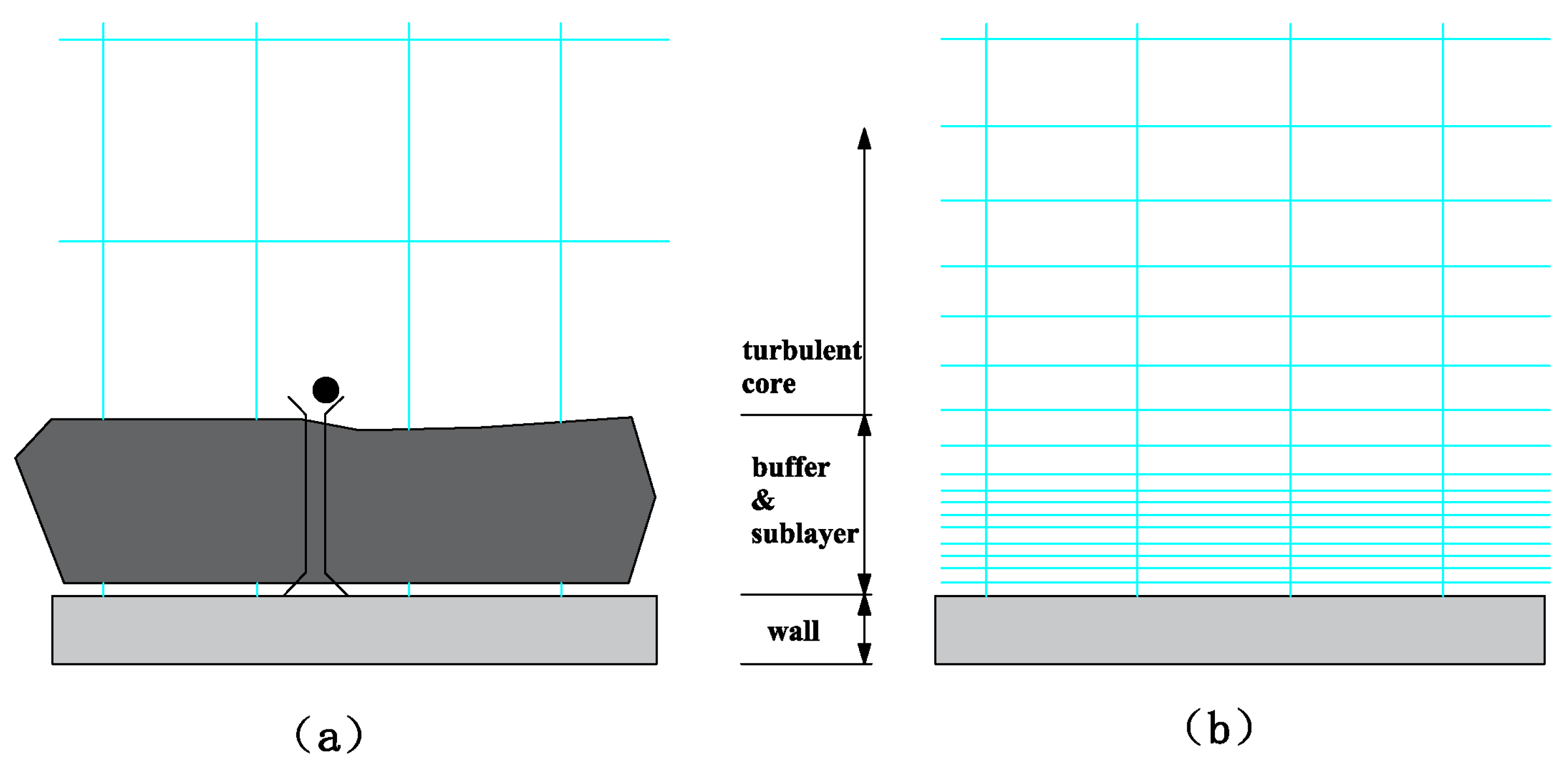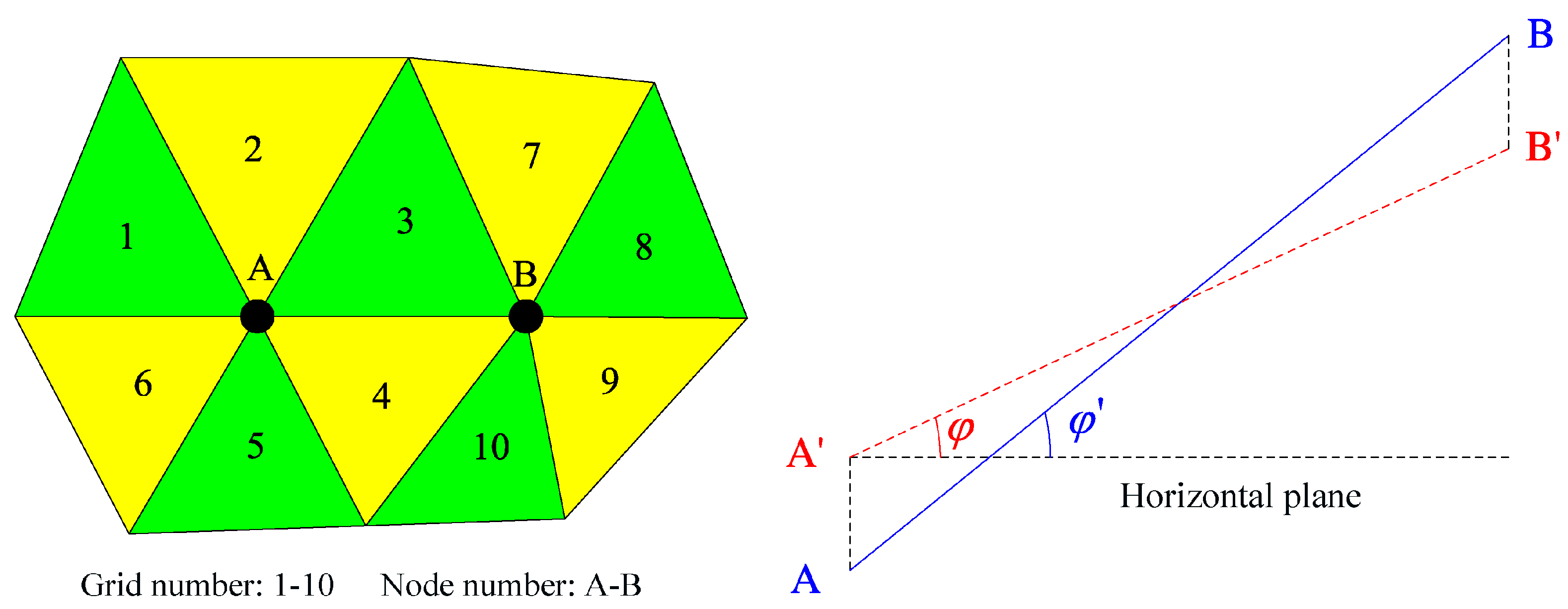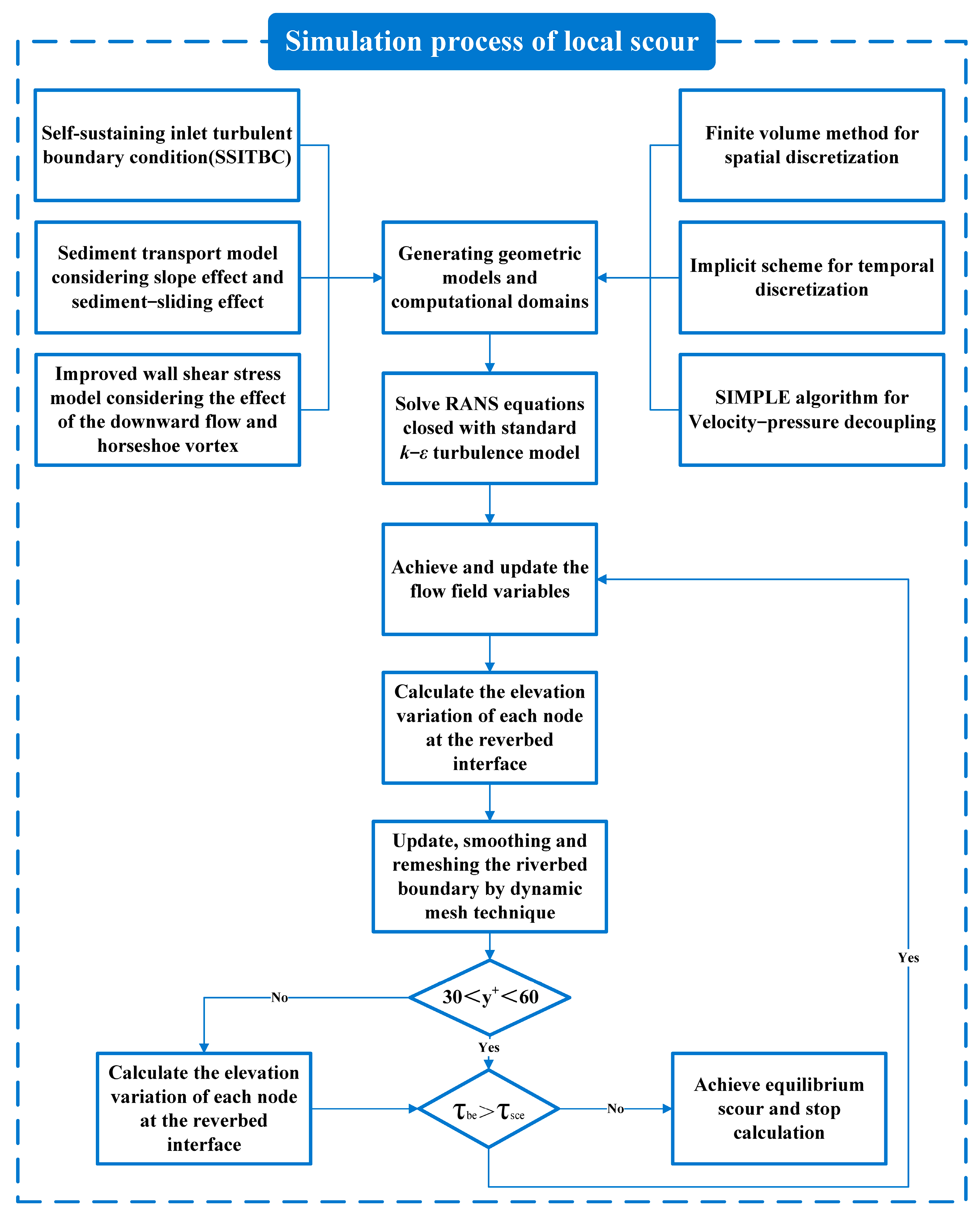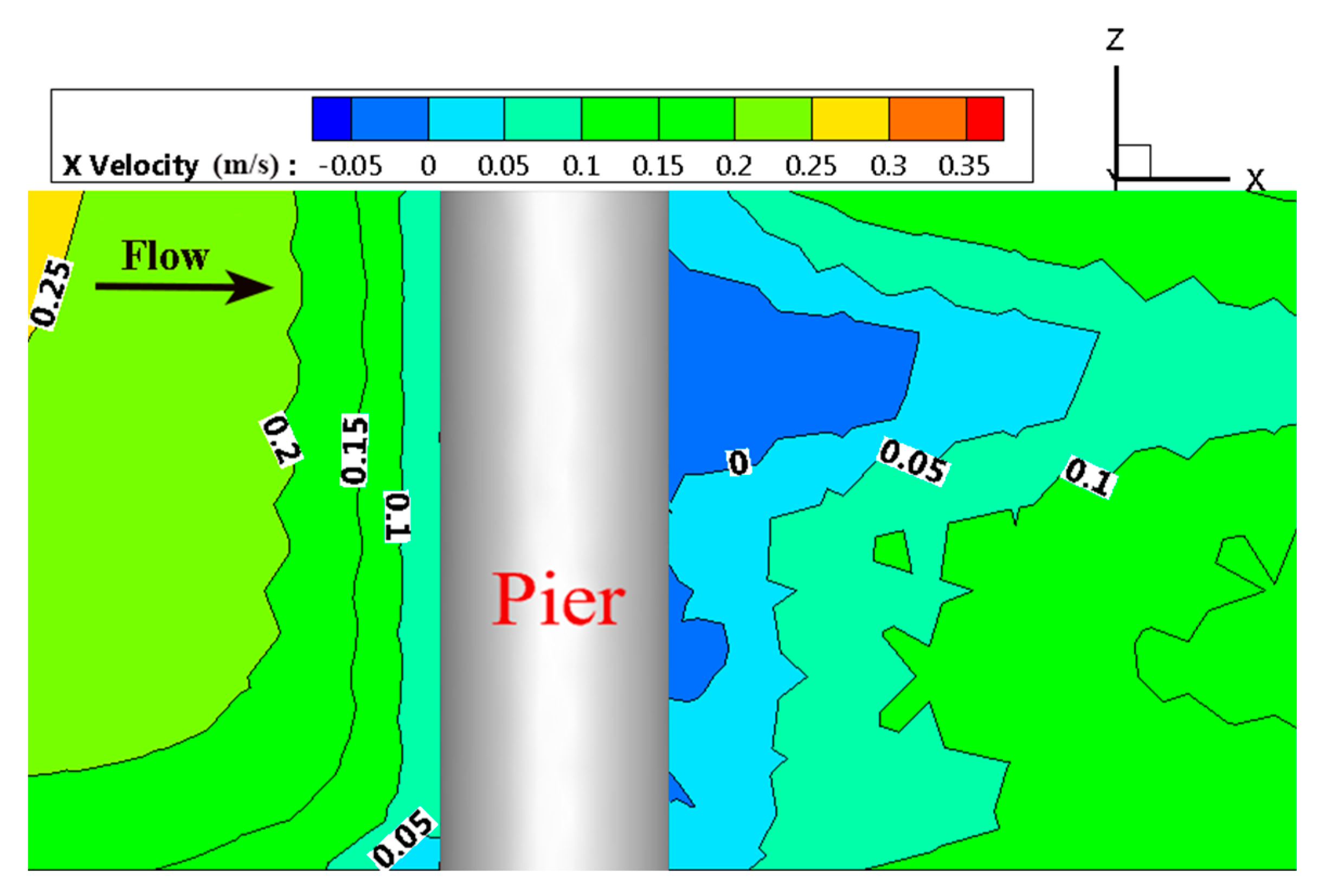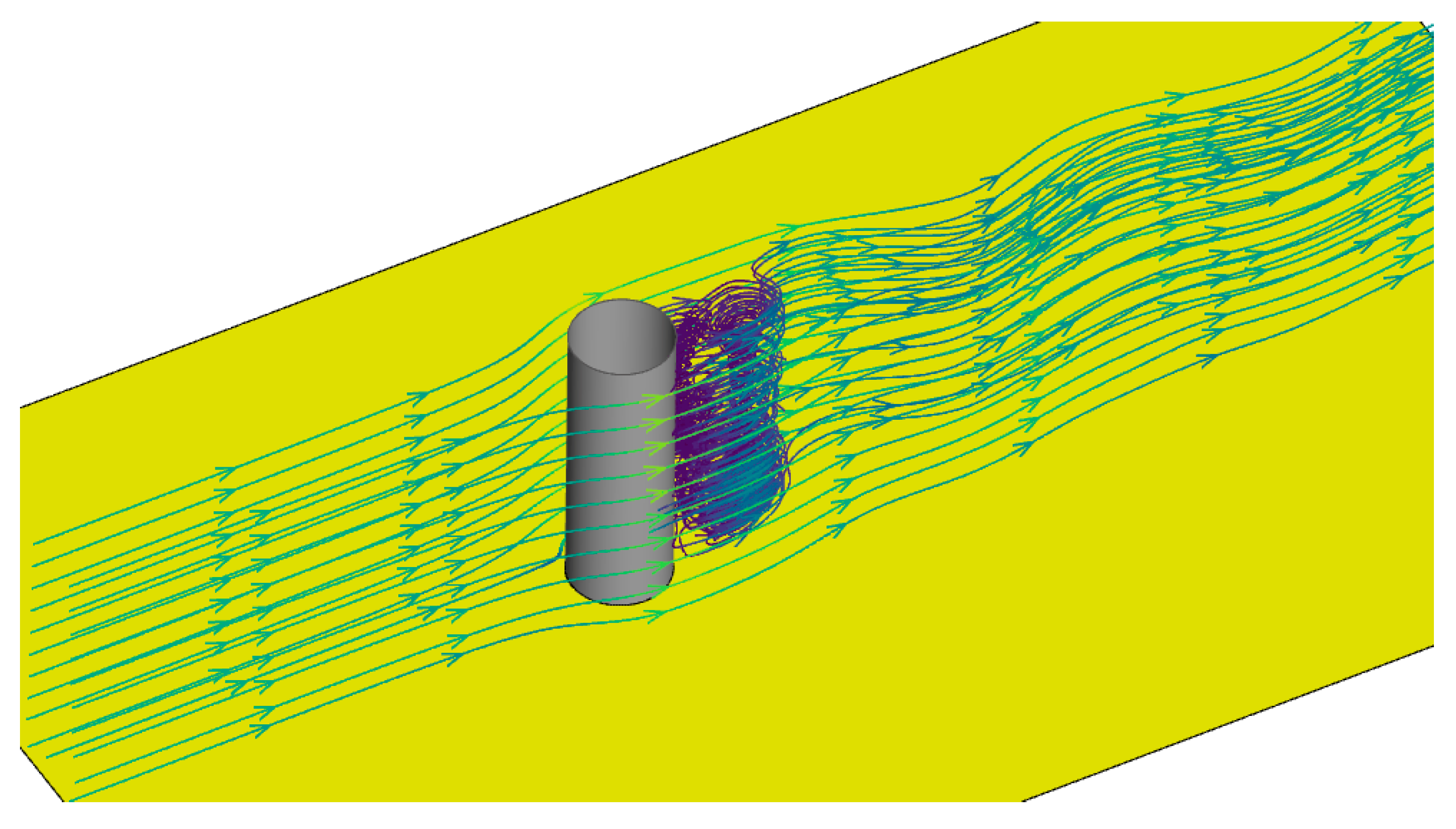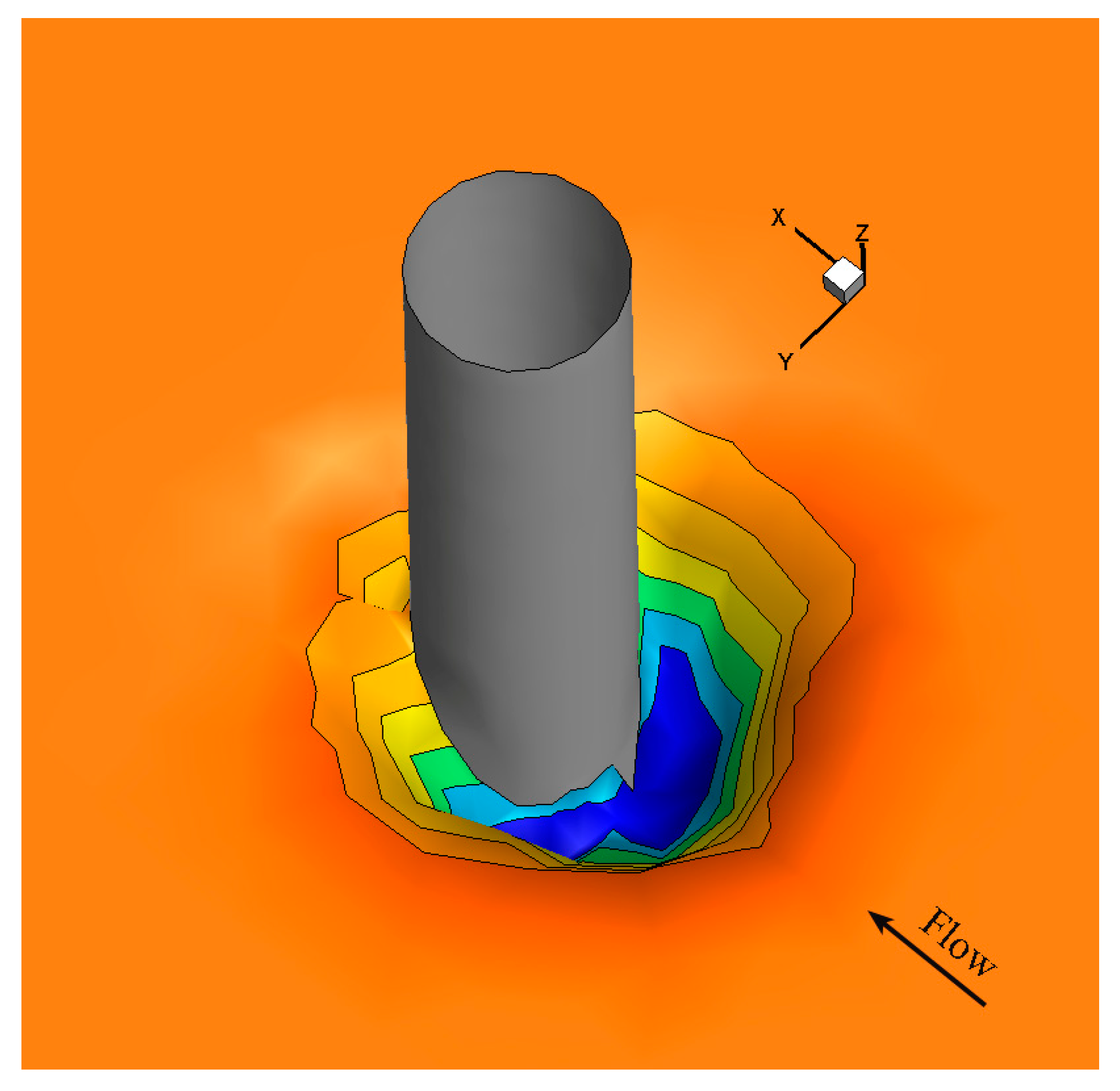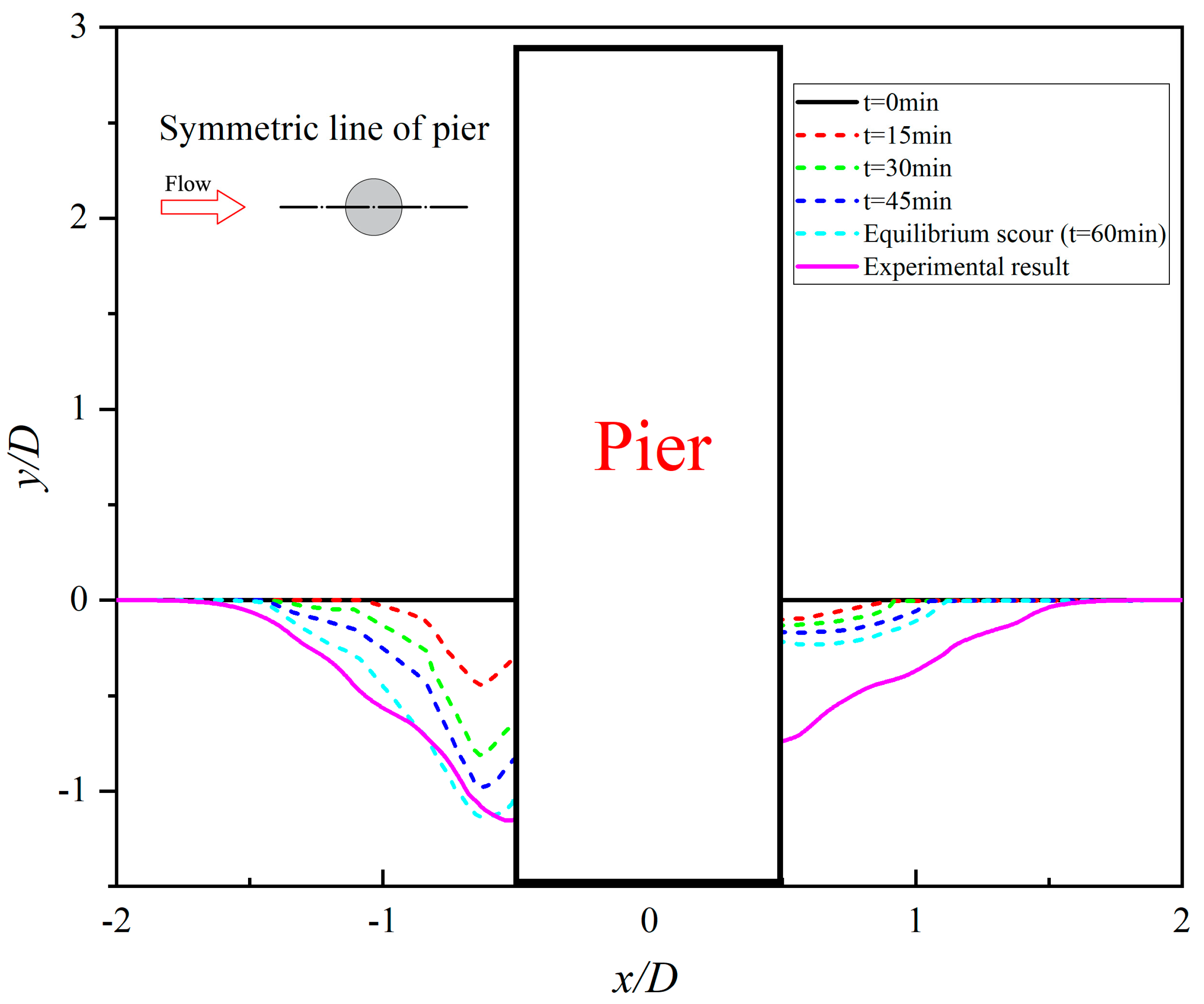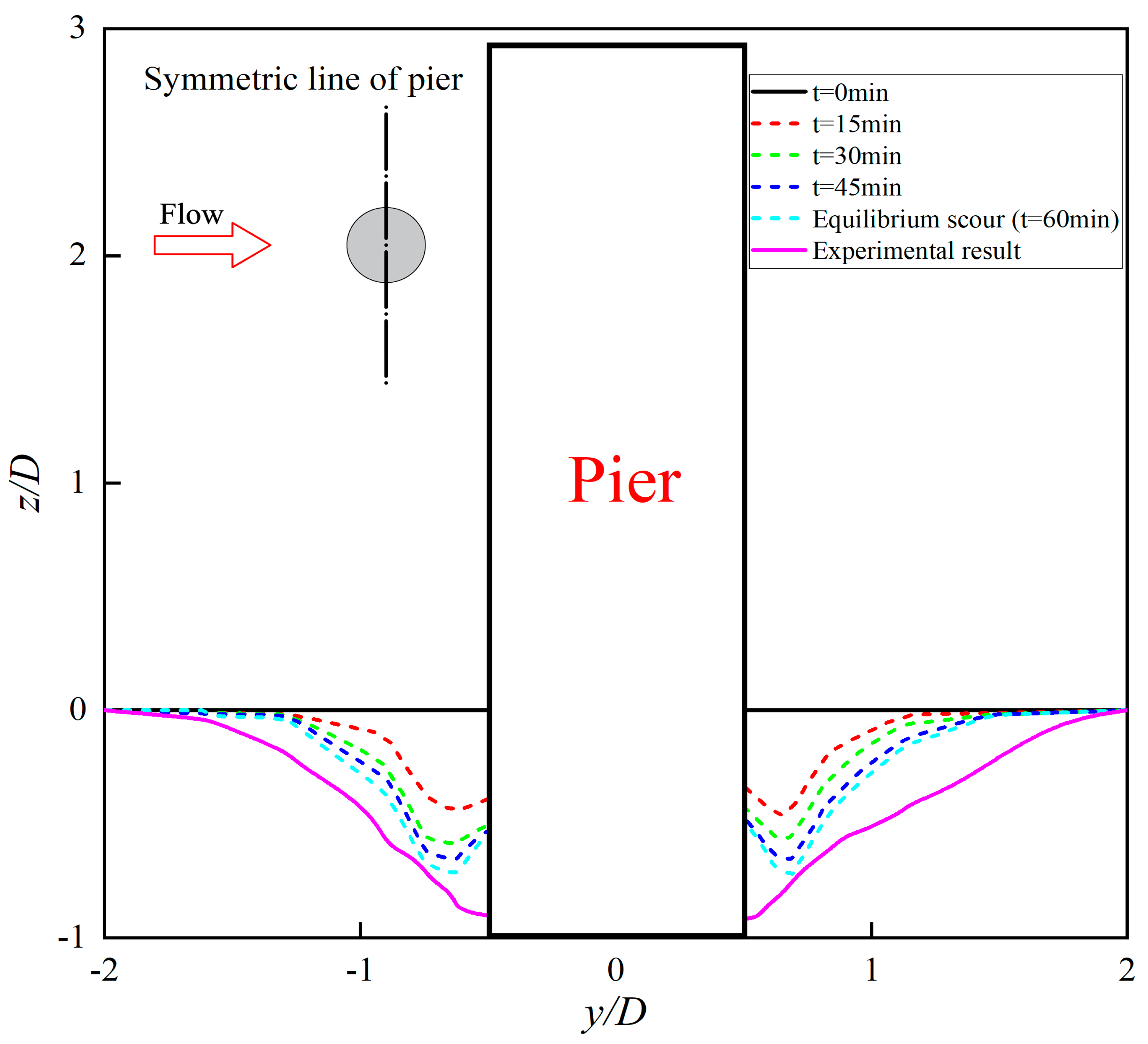1. Introduction
Bridges, as vital components of lifeline engineering, must endure various loads and natural disasters. The foundation of a bridge over water is submerged and constantly eroded by the approaching current. The sediment around the bridge foundation is entrained by the vortex created by the obstruction of the bridge structure and swept away by the approaching current, reducing the burial depth of the bridge foundation and weakening its bearing capacity. Additionally, potential safety hazards or damage to bridge foundations are easily overlooked due to water shielding. If the structure is damaged or defective, coupled with the scouring or impact of extreme disasters such as floods, it can easily lead to bridge water damage accidents.
Currently, research on bridge foundation scour primarily concentrates on scour mechanisms, prediction of scour depth, and scour protection measures [
1]. Methods employed encompass on-site observation [
2], flume experiments [
3,
4,
5,
6,
7,
8,
9,
10,
11], and numerical simulations [
11,
12,
13,
14,
15]. On-site observation accurately depicts the real-time local scour of bridge prototypes, while long-term monitoring keeps track of the bridge’s health, offering early warnings for potential hazards. Nevertheless, the high cost of equipment and numerous on-site interference factors hinder the study of bridge foundation scour mechanisms. Physical flume experiments aid in exploring the impacts of various factors, predicting maximum scour depth, and refining scour calculation and protection methods, thereby providing a scientific foundation and reference for addressing practical engineering issues. However, these experiments face limitations, including difficulties in achieving similarity relationships, introducing scale effects through scaling models, causing local disturbances in the flow field due to detection instruments, and challenges in gathering flow field data near walls. Numerical simulations of local scour based on computational fluid dynamics (CFD) can precisely capture the full spatiotemporal characteristics of the flow field, visualize various complex flow phenomena, and facilitate a deeper understanding of the micro-mechanics of complex turbulence and the spatiotemporal evolution of local scour. This, in turn, visualizes the dynamic evolution of scour. Additionally, numerical flumes enable rapid changes in model parameters, facilitating systematic studies on the impact of various key influencing factors on the local scour of complex pile groups. They offer advantages in terms of cost-effectiveness and efficiency. They can serve as a valuable complement to physical flume experiments, with both approaches mutually validating each other.
For decades, extensive studies have been conducted on Computational Fluid Dynamic (CFD) cases of local scour in bridge foundations [
14,
16,
17,
18,
19,
20]. In previous CFD simulations of local scour, the numerical methods employed can be broadly categorized into three types. The first type of method utilizes the Euler method for local scour CFD simulations [
12,
14,
15,
16,
17,
21]. In this approach, the bottom of the computational domain primarily serves as the riverbed interface. Turbulence models are used to simulate flow field characteristics, while sediment models calculate the scour and deposition deformation of the riverbed elevation. This is achieved by altering the shape of the bottom boundary to mimic the dynamic evolution of local scour. This method discretizes space using a grid, where the riverbed terrain undergoes substantial deformation over time, posing challenges to grid quality. The second method combines the Euler and Lagrange methods for CFD simulations of local scour. The most representative method is the CFD-DEM approach [
19,
20,
22]. The water flow region is spatially discretized through a grid to calculate flow field characteristics, while particle simulation is employed to analyze the forces on sediment particles in the sediment layer, thereby simulating their movement. The third type of method relies entirely on the Lagrange method. The most prominent example is the meshless smooth particle hydrodynamics (SPH) method [
23,
24,
25]. Both the water flow and sediment regions are simulated using particle size analysis. The particle method offers greater flexibility in simulating large deformations of riverbed terrain.
When conducting local scour CFD simulations based on the Euler method, most studies utilize the
k −
ε turbulence model to solve the Navier–Stokes equations, characterizing the complex flow around bridge piers. Additionally, sediment transport and the sediment-sliding model are employed to simulate the scouring and deposition deformation of riverbed sediment. The RANS model uses empirical wall functions to handle the flow in the viscous sublayer near the riverbed, which can reduce the number of grids, save computational time, and mainly adapt to the deformation of dynamic grids, avoiding grid distortion during large deformation of the riverbed during local scouring. However, compared to methods like direct numerical simulation (DNS) and large eddy simulation (LES), the RANS method introduces certain distortions when simulating strong eddies, buoyancy effects, and streamlined bending [
26]. So far, the LES and DNS models have only been used to simulate the flow field around piers with prefabricated scour holes [
27]. Therefore, until LES, DES, and DNS models can effectively simulate sediment transport and local scour processes over time, the RANS model is still useful for studying local scour around bridge piers [
28].
Currently, there are two notable issues in CFD simulations of local scour on bridge foundations: firstly, the self-sustaining characteristics of the prescribed inlet turbulent boundary conditions along the flow direction. Due to energy dissipation, the imposed velocity and turbulent kinetic energy (TKE) at the inlet gradually decay. Notably, the wall shear stress is estimated based on the velocity and turbulence energy near the wall. The attenuation of velocity and TKE near the riverbed wall directly impacts the calculation of shear stress on the wall, resulting in deviations in the simulation outcomes of local scour. To address this issue, the author theoretically derived a self-sustaining model (SSM) based on the assumption of local turbulence equilibrium. This model, along with the corresponding novel self-sustaining inlet turbulent boundary conditions (SSITBC), can swiftly develop a balanced turbulent boundary layer, which ensures that the turbulent characteristics of the approaching water flow accurately reflect the impact on local scour around the bridge pier, aligning with actual physical conditions. Secondly, the position of the maximum scour depth around the pier, as simulated, does not align with experimental results [
26,
29]. Research indicates that this discrepancy may stem from incomplete capture of the unsteady characteristics of downward-flow and horseshoe vortices by RANS methods and turbulent eddy viscosity models. The traditional wall shear stress model fails to accurately depict the sediment transport process caused by the horseshoe vortex and downward flow in front of the bridge pier in the simulation outcomes.
Therefore, to ensure consistency between the numerical and physical flow fields in the model area, the SSM proposed by the author was utilized to impose inlet boundary conditions on the CFD simulation of local scour. To reasonable reflect the contributions of downward flow and horseshoe vortex to local scour, this paper considers incorporating the velocity of the downward flow in front of the pier and the average wall shear stress around the pier into the excess shear stress formula, thereby calibrating the wall shear stress calculation model. Finally, the applicability of the proposed method is verified based on Melville flume experiments, revealing the water flow characteristics and scour mechanisms during the evolution of local scour. This provides a reference and basis for CFD simulations of local scour in water-related structures such as bridges and offshore wind turbines in the future.
2. Numerical Model
2.1. Governing Equation
The current can typically be assumed to be a continuous, incompressible fluid based on the three-dimensional, incompressible Reynolds-Averaged Navier–Stokes (RANS) equation. The continuity equation and momentum equation are expressed as follows [
30]:
where
is the time.
is the density of fluid.
are the coordinate components
x,
y,
z, in the Cartesian coordinate system.
are the average velocity in
x, y, z direction component.
are the fluctuation velocity in
x, y, z direction component.
is the dynamic viscosity.
is the pressure.
Fi is the volumetric force acting on the fluid.
is Reynolds stress.
2.2. Turbulence Model
In the aforementioned RANS equation, the introduction of Reynolds stress renders it non-closed. To solve the RANS equation, a vortex viscosity model, grounded in the Boussinesq hypothesis, is employed to translate the Reynolds-stress solution into the determination of the vortex viscosity coefficient.
Here,
is turbulent viscosity.
is turbulent kinetic energy (TKE).
is the dissipation rate of turbulent energy consumption.
is the empirical coefficient.
is Kroneck. The determination of turbulent viscosity requires a solution to the dual equation
turbulence model, whose governing equation is as follows:
where
is the TKE generation term, which is caused by the average velocity gradient. Based on the eddy viscosity assumption of Boussinesq,
.
and
are user-defined source items.
is an empirical constant. The default values of the standard turbulence model are given in
Table 1 [
26].
2.3. Self-Sustaining Model (SSM)
From the experimental results [
17], it can be observed that although the water flow velocity on both sides of a single cylindrical bridge pier increases after water blocking, the maximum scouring depth of the single cylindrical bridge pier mainly occurs at the leading edge of the pier. This is mainly because the undercurrent and horseshoe vortex system at the front edge of the bridge pier have an impact, suction, and entrainment effect on the sediment at the front edge of the bridge pier, accelerating the development of the scour depth at the front edge of the bridge pier. This indicates that the turbulent characteristics of water flow contribute significantly to the local scour of bridge piers. In CFD simulations of local scour, the strength of vortices can be characterized by turbulent energy. Therefore, in addition to focusing on the development of the inlet velocity profile along the flow direction, the development of turbulence characteristics such as TKE along the flow direction also needs to be taken into account. The self-sustaining characteristics of turbulent boundary conditions given at the inlet play an important role in the refinement simulation of local scour CFD.
Turbulence inherently possesses a dissipative nature. Turbulent motion is accompanied by a loss of mechanical energy. If no other forms of energy are available for replenishment during turbulent motion, the energy of the turbulent motion will gradually decay. Therefore, in CFD simulations of local scour, it is necessary to find a method that can simulate the equilibrium turbulent boundary layer, providing a new approach for studying local scour problems under specified turbulent boundary conditions.
Based on the assumption of local turbulence equilibrium, the generation term of TKE is equal to the dissipation term. We derived a self-sustaining model (SSM), adopting the solution of its partial differential equation as the boundary condition for turbulence. The specific derivation process is as follows:
The expression of the velocity profile is assumed as the logarithmic distribution:
where
is the roughness length.
is the constant of Von Karman, usually taken as 0.41.
is friction velocity. Substituting Equations (6)–(8) into Equations (3) and (4) yields the following:
The solution expressions of the combining Equations (8)–(10) are given in
Figure 1. Here, the determination of parameters
B1 and
B2 is based on the least squares nonlinear fitting method and flume test data. The detailed process can be found in Yu et al. [
31].
2.4. Near-Wall Treatment Methods
The treatment of near-wall regions typically involves two methods. The wall function method (refer to
Figure 2a) employs a semi-empirical formula to address the viscosity-affected zone between the wall surface and the fully turbulent region. However, the internal area influenced by viscosity, encompassing the viscous sublayer and buffer layer, remains unresolved. In another near-wall model approach (see
Figure 2b), the viscosity-affected region is solved using a fine mesh [
17].
The semi-empirical wall function is utilized to address the incompletely developed turbulence in the viscous sublayer. Typically, the semi-empirical formula for the wall function follows the logarithmic law, as depicted in Equation (11) below:
where
is the non-dimensional velocity.
is the friction velocity.
is the wall shear stress.
is the dimensionless length, 30 <
< 60 [
31].
is the distance to the wall.
is the kinematic viscosity.
is the roughness parameter, usually taken as 9.0. The wall shear stress yields the following:
2.5. Sediment Transport Model
The formula for calculating the critical shear stress (
) on a flat riverbed is as follows [
32]:
where
is the median particle size of sediment.
is the relative density.
is gravitational acceleration.
is sediment density.
is the critical Shields number. The value of
depends on the value of
, and the specific calculation formula refers to Equation (14), in which
[
13].
The terrain of natural riverbeds is not flat. Gravity exerts an influence on both the transport process of sediment and the state of the sediment itself. As shown in
Figure 3, the shear stress of a flat riverbed is substituted by equivalent shear stress [
33], which is obtained by analyzing the combined force of water resistance and gravity [
13].
Here, is the equivalent critical shear stress. is the equivalent shear stress. is the angle of sediment repose. γ is the angle between the directions and the normal direction on riverbed. is the shear stress of the riverbed. is the direction cosine in the direction.
The excess shear stress
T is given as shown in Equation (17).
The observation results from numerous local scour flume tests on single cylindrical piers reveal that the maximum scour depth occurs at the leading edge of the pier [
9,
11]. In this area, the scour depth is significantly influenced not only by the sediment-carrying effect of the approaching water flow but also by the subsurface flow and horseshoe vortex system. To accurately reflect the contribution of turbulent flow characteristics in this region to scouring and to simulate the true shape of the scour pit, we intend to extract the vertical component of water depth in front of the bridge pier and the average shear stress surrounding the pier to adjust the excess shear stress value.
Here, is the empirical constant. is the average riverbed shear stress around the bridge foundation. is the average vertical velocity component near the riverbed area at the front edge of the bridge foundation. is the infinite norm of the vertical velocity component at the leading edge of the bridge foundation.
The formula for sediment transport rate is as follows:
The sediment transport rate
is decomposed into the streamwise sediment transport rate
and cross-flow sediment transport rate
, respectively.
Here, , are the angles between the directions and the normal direction of riverbed, respectively. , are the stream-wise and cross-flow riverbed slope. , are the direction cosine in the and directions.
The expression for the change in riverbed topography over time is shown in Equation (22).
2.6. Sediment-Sliding Model
During the process of scouring, the approaching flow is carrying and entraining the sediment particles onto the slopes of scour pit. When the angle between the sand grains is slightly higher than the angle of repose of the sediment, the sediment particles will slide down to reach a new equilibrium and finally stop at an angle slightly lower than the angle of repose of the sediment. To accurately represent this process and reasonably simulate the actual sediment scour and deposition process as well as the shape of the scour pit, a sediment-sliding model is considered for characterization. In the numerical implementation process, the sediment transport rate is calculated by scanning all grid nodes along the riverbed boundary, extracting the shear stress on the riverbed wall, and further calculating the elevation changes of the riverbed nodes. The specific calculation process is shown in
Figure 4, while
Figure 5 illustrates a working mechanism of the sediment-sliding model. When the inclination angle of the connection between adjacent grid nodes scanning the global grid is greater than the angle of repose of the sediment, the positions of the nodes at both ends of the connection will be dynamically adjusted to be equal to the angle of repose of the sediment to maintain a balanced state at the angle of repose of the sediment.
Here, and are the coordinates of Points A and B, respectively. , are the variations in Points A and B, respectively. A1 … A10 is the area of the adjacent surface between A and B.
5. Conclusions
This article conducts a numerical study on the local scour of a three-dimensional single-cylinder pier based on a self-sustaining model and an improved wall shear stress model. The main conclusions are as follows:
The self-sustaining model (SSM) proposed can quickly simulate the equilibrium turbulent boundary layer at the riverbed wall, optimize and enhance the self-sustaining characteristics of the specified velocity and TKE profile at the inlet, and ensure the consistency of the turbulence characteristics in the model area with the target value. In addition, when studying structures such as underwater oil pipelines, turbulent pulsation characteristics are particularly important, especially when it comes to vortex-induced vibration problems in flexible pipelines and vortex sand-carrying problems caused by local scour around pipelines. Therefore, self-sustaining models can provide new ideas and methods for the fine simulation of specified flow conditions in the CFD simulation of these issues.
The proposed improved wall shear stress model can effectively solve the problem of insufficient estimation of local scour depth in the area by the downward flow and horseshoe vortex system in front of the pier. The maximum scour depth obtained from the simulation is consistent with the experiment in terms of both size and location. However, there are still some shortcomings in the estimation of scour and sedimentation in the wake area of bridge piers. In the future, the accuracy of the model’s scour and deposition estimation in the wake region will be further optimized and improved. Furthermore, this provides a reference and basis for the detailed simulation of scour on structures such as bridge foundations, offshore wind turbines, and submarine pipelines in the future.

